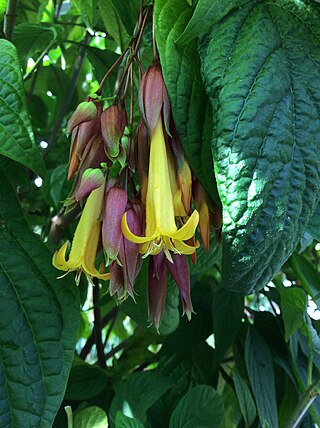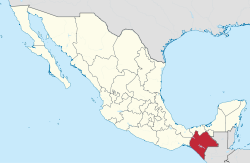Top Qs
Timeline
Chat
Perspective
Deppea splendens
Species of plant From Wikipedia, the free encyclopedia
Remove ads
Deppea splendens, commonly known as the golden fuchsia,[5][6] is a species of flowering plant in the family Rubiaceae endemic to Chiapas, Mexico.[3] It is extinct in the wild.[1][3] Despite its common name, it is not closely related to the true Fuchsia genus.[7]
This article has multiple issues. Please help improve it or discuss these issues on the talk page. (Learn how and when to remove these messages)
|
Remove ads
Description
Vegetative characteristics
Deppea splendens is an evergreen,[8] 5–8 m (16–26 ft) tall shrub or tree with glabrous twigs.[9] The petiolate,[2] stipulate,[10] elliptic to ovate-elliptic leaves with an acuminate apex are 4.5–15 cm long, and 0.8-6 cm wide.[2] The petiole is 0.8–3.8 cm long.[10]
Generative characteristics
The terminal,[9] pendulous, brightly coloured inflorescences[11] bear 16–25[9] pendulous, tubular,[6] tetramerous,[7] ornithophilous[9] 5–[12][7]6 cm long flowers[13] with a red calyx and yellow-orange petals.[6] The tricolporate pollen grains are 21.9–25.7 μm big.[14] The compressed, ellipsoid, 6–8 mm long, and 5–7 mm wide loculicidal capsule fruit bears dark brown, 0.6–1 mm long seeds.[15]
Remove ads
Taxonomy
It was described by Dennis Eugene Breedlove and David H. Lorence in 1987.[2] Dennis Breedlove was a botanist at the California Academy of Science researching plants and ethnobotany in Chiapas when he discovered it in 1972 in the Motozintla de Mendoza municipality; he brought seeds of the then undescribed shrub to San Francisco in 1981 (he described it formally in 1987). That seed was grown at the University of California Botanical Garden. All plants in existence are from that introduction. It is now grown widely grown, including in the San Francisco Conservatory of flowers, The San Francisco Botanical Garden at Strybing Arboretum, and at the Huntington in Southern California.[16] Within the subfamily Dialypetalanthoideae it is placed in the tribe Hamelieae.[17]
Etymology
The specific epithet splendens means shining or brilliant.[18]
Remove ads
Distribution and habitat
It was once native to high elevation cloud forest in the state Chiapas, Mexico, but has been presumed extinct in the wild since its habitat was cleared for farmland. It is now found only in horticulture, although efforts have been made to reintroduce it in Mexico.[16][1]
Conservation
The only known population was destroyed for farmland.[19][20] It only persists in ex-situ collections[20] in botanic gardens and private collections.[21] Deppea splendens is self-incompatible,[13][12] but several clones are known to exist.[22] It can also be propagated vegetatively.[13]
Ecology
The flowers are pollinated by hummingbirds.[9][19][7]
Cultivation
It can be easily cultivated[21] in well-drained, nutrient rich substrate under bright and warm conditions,[19] but does not tolerate consistently hot and humid climates.[21]
References
Wikiwand - on
Seamless Wikipedia browsing. On steroids.
Remove ads



